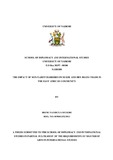| dc.description.abstract | The East African Community (EAC) committed to elimination of non-tariff barriers (NTBs) in
order to realize the benefits of a single economic market, following gradual removal of tariffs on
intra-regional trade by signing and ratifying the EAC treaty and customs union protocol.
However, since its re-launch in 1999 numerous sources of non-tariff trade barriers persisted to
impede trade among the EAC Partner States thereby defeating the purpose and spirit of regional
integration. This study examined the impact of NTBs on intra-regional trade in two agricultural
commodities; maize and beans using three models namely; the economic surplus model to
estimate the benefits that would be realised with elimination of NTBs, Faini Model to evaluate the
price elasticity of maize demand and Wu model to estimate trade loss incurred due to NTBs.
Agricultural trade accounts for more than 65% of EAC traded commodities by volume. Maize and
beans were selected for study as they were not only major staple food crops in this region, but
also most traded agricultural commodities that contributed significantly to income generation for
rural households. This study was carried out through analysis of existing secondary data as well
as primary data collected from stratified randomly sampled respondents.
The objectives of this study were; to identify the different types of Non-Tariff Barriers that affect
maize and beans trade within the EAC, evaluate the extent to which the main Non-Tariff Barriers
affect maize and beans trade in the region, estimate trade benefits that would accrue to the region
with reduction and eventual elimination of NTBs and lastly, identify the main factors that
contribute to persistence of Non-Tariff Barriers in maize and beans trade in the EAC region. The
results of this study identified twelve types of NTBs and the three main ones ranked according to
their statistical significance levels were; road blocks, unclear and cumbersome documentation
required of the traders and other stakeholders as well as the unclear and varying trade regulations
such as SPS measures, KEPHIS certificate, KEBS standards and axle load requirements.It
revealed that a total of 23 documents were required at one time or another of a trader on transit to
neighbouring Partner States which should not be the case with customs union and the common
market protocols in place. It revealed that over 95 percent of maize and beans trade was carried
out through informal channels due to prevalence of NTBs.This therefore implied that NTBs
caused 95 percent maize and beans trade loss to the EAC region. The potential benefits that the
region stands to gain with reduction and eventual elimination of NTBs in the region was
estimated to be US dollars 20.41 trillion worth of annual trade in maize and beans subsectors.
The main causes of persistent NTBs in the region were: firstly,at regional level they includelack
of harmonized standards, lack of enforcement mechanism for harmonized issues and lack of
iv sufficient will power by Partner States to implement harmonized policies. Secondly, at national
level the main factors were provision of inadequate public facilities, insufficient technically
qualified staff, inadequate power supply and inappropriate clearance technology.
Finally, the study provided trade policy recommendations to improve trade among EAC Partner
States as well as the livelihoods of the EAC citizens. The main recommendation provided was
that the Governments of the five Partner States should endeavour to enhance their will power and
commitment towards regional integration of the EAC. They should endeavour to invest in
streamlining trade and sensitization of the stakeholders since reduction and eventually elimination
of NTBs identified in this study were paramount and would reduce the costs of doing business
and contribute to the realization of increased revenues. Partner States should invest in public
utility facilities such as supply of power, human resource and automated clearance systems while
fast tracking harmonization of regional trade policies and regulations as well as implementation of
those already harmonised. The results indicate that with the magnitude of the amounts of maize
Kenya imports it should not export any maize at all.In fact Kenya should endeavour to increase
production through more innovative means. There is need to streamline administrative procedures
and regulations of cross border agricultural trade. There is need to simplify business registration
and improve the efficiency of transit agricultural goods clearance at border points.Customs
requirements should be made more transparent and clear while information flows should be made
more easily available to all stakeholders by embracing modern technologies like ICT. Lastly, it
recommended fast-tracking elimination of NTBs along major transit routes in the EAC region and
improve the efficiency aspects to facilitate trade flows in the region by hastening the
harmonization process of key trade policies. | en_US |

